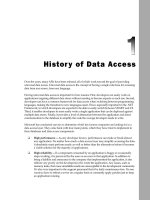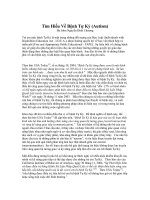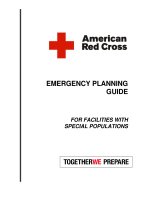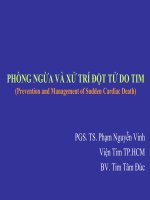Tài liệu Understanding Controversial Therapies for Children with Autism, Attention Deficit Disorder, and Other Learning Disabilities docx
Bạn đang xem bản rút gọn của tài liệu. Xem và tải ngay bản đầy đủ của tài liệu tại đây (768.41 KB, 212 trang )
Understanding Controversial Therapies
for Children with Autism,
Attention Deficit Disorder,
and Other Learning Disabilities
JKP Essentials
Understanding Motor Skills in Children with Dyspraxia, ADHD, Autism,
and Other Learning Disabilities
A Guide to Improving Coordination
Lisa A. Kurtz
ISBN 978 1 84310 865 8
Visual Perception Problems in Children with AD/HD, Autism, and Other
Learning Disabilities
A Guide for Parents and Professionals
Lisa A. Kurtz
ISBN 978 1 84310 826 9
Dyslexia and Alternative Therapies
Maria Chivers
ISBN 978 1 84310 378 3
Understanding Regulation Disorders of Sensory Processing in Children
Management Strategies for Parents and Professionals
Pratibha Reebye and Aileen Stalker
ISBN 978 1 84310 521 3
Understanding Nonverbal Learning Disabilities
Maggie Mamen
ISBN 978 1 84310 593 0
Understanding Controversial
Therapies for Children with Autism,
Attention Deficit Disorder,
and Other Learning Disabilities
A Guide to Complementary
and Alternative Medicine
Lisa A. Kurtz
Jessica Kingsley Publishers
London and Philadelphia
First published in 2008
by Jessica Kingsley Publishers
116 Pentonville Road
London N1 9JB, UK
and
400 Market Street, Suite 400
Philadelphia, PA 19106, USA
www.jkp.com
Copyright Ó Lisa A. Kurtz 2008
All rights reserved. No part of this publication may be reproduced in any material form
(including photocopying or storing it in any medium by electronic means and whether or not
transiently or incidentally to some other use of this publication) without the written permission
of the copyright owner except in accordance with the provisions of the Copyright, Designs and
Patents Act 1988 or under the terms of a licence issued by the Copyright Licensing Agency Ltd,
Saffron House, 6–10 Kirby Street, London EC1N 8TS. Applications for the copyright owner’s
written permission to reproduce any part of this publication should be addressed to the
publisher.
Warning: The doing of an unauthorized act in relation to a copyright work may result in both a
civil claim for damages and criminal prosecution.
Library of congress cataloging in Publication Data
Kurtz, Lisa A.
Understanding controversial therapies for children with autism, attention deficit disorder, and
other learning disabilities : a guide to complementary and alternative medicine / Lisa A. Kurtz.
p. cm. -- (JKP essentials series)
ISBN 978-1-84310-864-1 (pb : alk. paper) 1. Learning disabilities--Alternative treatment. 2.
Autism in children--Alternative treatment. 3. Attention-deficit hyperactivity
disorder--Alternative treatment. I. Title.
RJ496.L4K87 2008
618.92'85889--dc22
2007035919
British Library cataloguing in Publication Data
A CIP catalogue record for this book is available from the British Library
ISBN 978 1 84310 864 1
ISBN pdf eBook 978 1 84642 761 9
Printed and bound in Great Britain by
Athenaeum Press, Gateshead, Tyne and Wear
CONTENTS
Part 1:
Introduction
1. Introduction
2. Thinking Out of the Box: An Overview of
Complementary and Alternative Medicine
Approaches
Part 2:
11
15
Selected Interventions
3. Alternative Medical Systems
Acupuncture/Acupressure
Ayurveda
Homeopathy
Naturopathy
Osteopathy
25
25
27
30
32
35
4. Mind-body Interventions
Alert Program
Animal Assisted Therapy
Applied Behavioral Analysis
Aromatherapy
Art Therapy
Assistive Technology for Literacy Skills
38
38
39
41
47
49
51
Auditory Training
Colored Lenses and Overlays
Dance Movement Therapy
Davis Dyslexia Correction® Method
DIR®/Floortime model
Dolphin Assisted Therapy
DORE Programme
Drama Therapy/Psychodrama
Earobics®
Facilitated Communication
Fast ForWord®
Holding Therapy
Hypnotherapy
Intensive Interaction
Learning Breakthrough ProgramTM
Lindamood-Bell®
Miller Method
Multisensory Reading Instruction
Music Therapy
Neurofeedback
Picture Exchange Communication System (PECS)
Play Attention®
Primary Movement Program®
Rhythmic Entrainment Intervention (REI Therapy)
Sensory Integration Therapy
Sign Language
Social StoriesTM
Son-Rise Program®
TEACCH
Transcendental Meditation
Video Modeling
5. Biologically-based interventions
Bach Flower Remedies
Chelation Therapy
54
58
60
61
63
65
68
70
72
73
75
77
78
80
84
86
87
90
93
95
98
100
101
103
104
107
110
112
114
115
117
120
120
122
Cranial Electrotherapy Stimulation (CES)
DAN! Protocol
Dietary Supplements
Elimination Diets
Feingold Diet
Hyperbaric Oxygen Therapy
Immune System Therapy (IGG, IVIG)
124
126
128
132
134
137
139
6. Manipulative and Body-based Methods
Alexander Technique
Brain Gym®
Chiropractic
Conductive Education
Craniosacral Therapy
Developmental/Behavioral Optometry
Feldenkrais
Higashi (daily life therapy)
Hippotherapy
Interactive Metronome®
Massage Therapy
Patterning (Doman-Delacato method)
Reflexology
Wilbarger Protocol (Therapeutic brushing)
Yoga
142
142
144
145
148
150
152
155
158
160
162
164
167
169
171
173
7. Energy Therapies
Chromotherapy
Magnetic Field Therapy
Polarity Therapy
Qi Gong
Reiki
Therapeutic Touch
Zero Balancing
177
177
178
180
181
184
187
188
Part 3.
Resources for Children with Autism,
Attention Deficit Disorders, and Other
Learning Disabilities
8. Recommended Reading about
Complementary and Alternative Medicine
Books
Journal articles
9. Agencies, Organizations, and Websites
Complementary and Alternative Medicine
Children, including Children with Developmental
Disabilities
SUBJECT INDEX
AUTHOR INDEX
193
193
194
197
197
199
205
PART 1
INTRODUCTION
Chapter 1
INTRODUCTION
Children with disabilities are at risk for experiencing problems in many aspects
of their lives, including becoming independent in daily living skills, meeting
academic expectations, learning to communicate, maintaining emotional and
behavioral regulation, adapting to the social demands of society, and developing
motor proficiency. Among children with disabilities, those with autism
spectrum disorders, attention deficit disorders (ADD), and specific learning disabilities have received particular attention in the literature, and pose significant
challenges to parents, teachers, and other professionals who hope to provide
them with interventions that best ameliorate their difficulties.
Professionals who diagnose these disorders understand that certain defining
traits or characteristics are used to determine if a child “fits” the criteria for a
particular diagnosis, and have developed protocols for testing and clinical
assessment that can strongly suggest or confirm a diagnosis. For example, all
children with autism spectrum disorders demonstrate problems impacting
social reciprocity, communication, and behavior. Children with ADD display
developmentally inappropriate levels of inattention or hyperactivity that are not
related to medical or social-emotional factors, and that cause impaired adaptive
performance at home, in school, or in situations requiring social interaction.
Children with specific learning disabilities demonstrate a significant discrepancy
between their ability to learn (based upon measures of intelligence) and their
actual learning, and this discrepancy cannot be attributed to medical, economic,
cultural, or social disadvantages that might account for the discrepancy.
However, within each of these diagnostic groups, an enormous number of individual differences exist. Some children with autism learn to talk, while others
must be trained to use non-verbal forms of communication. Many children with
ADD are hyperactive, but others have under-responsive attention systems, and
are lethargic and slow to respond to learning challenges. Children with specific
11
12
UNDERSTANDING CONTROVERSIAL THERAPIES
learning disabilities exhibit wide variability as to their cognitive strengths and
weaknesses, learning styles, and response to various curricula and instructional
methods. Some children struggle with motor coordination or speech articulation, while others do not. Furthermore, some children with developmental disabilities may have related or concomitant disorders that complicate their
individual profile. The presence of hearing or vision impairments, emotional
disturbances, or other medical conditions greatly influences the impact of the
disability on the child’s ability to cope and to learn. Finally, factors such as the
child’s personality and temperament, emotional resilience, the strength and
commitment of family support, and the availability and affordability of appropriate services can also greatly influence the unique prognosis for each individual child.
With such wide variety in the learning styles and differences among these
children, it is no surprise that professionals have yet to agree upon the best practices for intervention. Certainly, guidelines do exist. There is significant pressure
within medical and educational communities to provide treatment that is based
upon scientific evidence of success and that focuses on relevant outcomes
(sometimes called evidence-based practice). This typically requires that the specific
intervention is isolated from other interventions, and is then subjected to a controlled study in which researchers look at the outcome of children who are
randomly selected to receive the targeted intervention as compared with
children who receive an alternative or no intervention. Because the researchers
are not told which children are receiving the targeted intervention, this is known
as a blind study. Treatments that have been subjected to multiple blind studies that
successfully document effectiveness, and that are then put through rigorous
review and critique by professional peers so that the results can be published in
reputable journals are often then accepted into conventional or mainstream
medical or educational practices. However, many types of intervention for
children with developmental disabilities do not lend themselves easily to this
type of study. Because of the variability of individual characteristics in children
with disabilities, it is often hard to put together a group of children who are
similar enough to be considered a “unique” group. If there is too much variability in the study group, and some subjects improve while others do not, it is hard
to know whether the changes that are observed relate to the intervention or to
individual differences among members of the study group. Also, many studies
take place over a period of weeks, months, or longer. If improvement occurs, it
is difficult to demonstrate whether improvement is attributable to normal maturation as opposed to the effects of the intervention. Furthermore, many interventions for developmental disabilities are dynamic in nature, requiring the
INTRODUCTION
13
development of a therapeutic rapport with the child, along with active participation on the part of the child, family, and others involved with the child. These
personal variables are difficult to control in a scientific study. This makes scientific study of developmental interventions potentially more complicated than
the study of effectiveness of a specific drug, exercise, surgery, or other more
concrete type of intervention.
The interventions that are commonly recommended by professionals may
be governed by a variety of regulatory practices that have been developed in
consideration of scientific evidence. In the United States, federal and state regulations offer standards and guidelines for providing services within early intervention and educational settings (see Individuals with Disabilities Education
Improvement Act (IDEIA) 2004). In the United Kingdom, a government code
of practice, the Special Educational Needs and Disability Act 2001, offers
guidance to local education authorities and state schools on how to identify,
assess, and monitor students with special learning needs. Professionals who are
licensed or otherwise regulated in their practice must operate within the scope
of practice as defined by their profession or by local regulatory agencies. Also,
the specific interventions recommended by professionals may or may not be
covered under various insurance or other reimbursement agencies. All of these
regulatory practices are designed to help to assure that children have access to
treatments that meet approved standards of care and are likely to be effective.
This book is intended to offer parents and professionals a brief overview of
certain non-conventional, controversial interventions that may be considered
for children with developmental disabilities including autism spectrum disorders, attention deficit disorders, and specific learning disabilities. Its purpose is
to help readers to understand the basic theory behind each intervention, the
typical procedures involved, and where to go for more information about the
intervention or about the qualifications of professionals using the intervention.
It is in no way meant to endorse or condemn any of the interventions described,
nor to offer medical or educational advice, but simply to help readers to expand
their knowledge of available interventions. The interventions discussed offer a
representative, but not comprehensive, overview of available therapies at the
time this book was written. Resources listed in the appendix can offer readers a
mechanism for staying informed about controversial therapies as scientific
evidence is gathered about those interventions included in this book, or as other
interventions become available.
14
UNDERSTANDING CONTROVERSIAL THERAPIES
REFERENCES
US Department of Education (2004) Individuals with Disabilities Education Act (IDEIA).
Available at accessed on
3 December 2007.
Special Educational Needs and Disability Act (2001) London: The Stationery Office.
Available at
www.england-legislation.hmso.gov/acts.acts2001/ukpga_20010010_en_1, accessed
17 December 2007.
DISCLAIMER
This book is intended for informational purposes only, and is not meant to
provide specific medical or psychoeducational advice. Opinions expressed are
those of the author, and should not be taken as an endorsement nor condemnation of any intervention method or procedure. All decisions about treatment for
children with disabilities should be made in consideration of the available scientific evidence for effectiveness and safety, and should be discussed with the
child’s pediatrician and other qualified professionals involved in the child’s care.
The author disclaims all liability, loss, injury, or damage incurred directly or indirectly as a result of use of any information contained in this book.
Chapter 2
THINKING OUT OF THE BOX
An Overview of Complementary
and Alternative Medicine Approaches
Medicine can be described as the practice of maintaining or restoring health
through the study, diagnosis, and treatment of disease and injury. Conventional
medicine refers to the provision of medical care as shared by doctors (Medical
Doctors or MDs, and Doctors of Osteopathy or DOs) and by allied health professionals, including nurses, psychologists, occupational therapists, speech-language
therapists, physical therapists, and others. The practice of conventional medical
care is regulated through various professional licensing and credentialing boards
that assure the public of the competency of members. In conventional
medicine, practices and interventions are based upon sound scientific research
that proves both the efficacy and safety of the intervention. These interventions
are therefore widely accepted among the broad medical community. Conventional medicine may also be referred to as Western medicine, orthodox medicine, mainstream medicine or allopathy.
Complementary and Alternative Medicine (CAM) refers to a diverse array of
health care systems, practices, and interventions that are not considered to be
part of conventional medicine. Although interventions included in this
category may have undergone research and may have popular acceptance
among consumers, there are generally insufficient data available to assure the
outcome and safety of the interventions. Training in the use of CAMs can be
highly variable, in some cases leading to credentialing, such as licensure for
massage therapists, or voluntary certification in certain auditory training
programs. Unfortunately, however, it is not uncommon for professionals to
incorporate use of CAMs as part of their practice with little or no formal
training. In fact, some lay personnel practice interventions with virtually no
15
16
UNDERSTANDING CONTROVERSIAL THERAPIES
formal professional training or credentialing, and with a very limited understanding of the basic concepts underlying the health and psychosocial
well-being of their clients. The list of interventions that are considered to be
CAMs undergoes continual change as some are proven effective and are
adopted by conventional medical practice, while newer therapies and
interventions are proposed and introduced to the public.
Although complementary and alternative medical practices are often
referred to together as CAMs, there are important distinctions between the two.
Complementary medicine refers to interventions that are used along with more conventional treatment. For example, yoga might be used to achieve a calm and
relaxed state prior to a challenging physical therapy exercise program, or
aromatherapy might be used to promote alertness prior to a reading instruction
session for a child with learning disabilities. The practice of using safe combinations of conventional and non-conventional medicine is sometimes referred to
as integrative medicine. Alternative medicine is used to describe interventions that take
the place of traditional medicine, for example, seeking treatment from a homeopathic physician instead of an MD or DO, or using elimination diets as a substitute for prescription medication to reduce hyperactivity in children with
attention deficit disorder. The use of CAMs has gained increasing popularity in
recent years, especially as there is greatly increased access to information about
therapeutic options through the Internet. For parents of children with lifelong
developmental differences, frustration with slow progress using more traditional approaches, or limited access to those services, may encourage them to
seek other answers. Parents may also choose to explore the use of CAMs based
upon the recommendations of friends or professionals they trust, or based
upon personal beliefs and traditions. For example, less invasive therapies may be
attractive to parents who fear the potential side effects of drugs used in conventional medicine, or they may find it easier to support a therapeutic intervention
that is consistent with their own activity preferences, such as music, dance or
martial arts. In fact, according to the National Institutes of Health, more than
one-third of adults in the United States use some form of complementary or
alternative medicine (Barnes et al. 2004). Most doctors of conventional
medicine are open to discussing the use of CAMs with patients and their
families, and some will consider making a referral under the right circumstances.
Other physicians, however, are cautious about recommending alternative
treatments due to their susceptibility for medical liability (American Academy
of Pediatrics 2002).
In 1992, the United States Congress created the National Center for Complementary and Alternative Medicine (NCCAM) as one component of the
THINKING OUT OF THE BOX
17
National Institutes of Health. This organization classifies CAM therapies into
five categories or domains. The subsequent chapter presents a description of
selected CAMs organized according to this model. The five domains are
described as follows:
1.
Alternative Medical Systems, based upon complete systems of theory
and practice, such as homeopathic medicine or Ayurveda.
2.
Mind-body Interventions. These use a variety of techniques designed to
enhance the mind’s capacity to affect bodily functions and symptoms
(for example, meditation or creative arts therapies).
3.
Biologically-based Therapies, which use substances found in nature, such
as herbs, foods, and vitamins.
4.
Manipulative and Body-based Methods, which are based on manipulation
and/or movement of one or more parts of the body, such as
chiropractic or massage.
5.
Energy Therapies, involving the use of energy fields. There are two
types of energy fields, Putative (also called Biofields), which
purportedly surround and penetrate the human body but cannot be
measured, and Veritable, which involve measurable wavelengths and
frequencies of sound, light, magnetism, or other types of rays from
the electromagnetic spectrum.
Parents and professionals who consider the use of CAMs for children with
autism, attention deficit disorder, learning disabilities, or other disabilities or
health care concerns should use caution when making such an important
decision. Some CAMs have undergone at least some promising research to
demonstrate effectiveness, but all CAMs included in this book should be considered unproven, at least as of the writing of this book. It is easy for parents and
professionals alike to be fooled into thinking a treatment “works” when there
are many anecdotal claims of success and media attention. However, placebo effect
may, in fact, be behind many claims of success. Placebo effect refers to the perception of positive outcomes of an intervention that may or may not be due to
the actual intervention. This can occur because with any intervention, scientifically proven or not, positive things usually happen. The professional enters into
a relationship with the child and family and gets to know them on a personal
level. He or she can then answer questions, offer helpful guidance about daily
issues or problems, and provide emotional support and optimism. All of this is
good, and can actually help the child to improve, but it may have nothing to do
with the actual intervention, per se. This is not to say that placebo effect is
18
UNDERSTANDING CONTROVERSIAL THERAPIES
necessarily bad, just that it warrants thoughtful consideration. Sometimes,
children who undergo a new treatment make gains simply because they feel
“special” or singled out, causing them to be more motivated and to work harder
at improving their skills. In general, it would seem wise to first try scientifically
validated, conventional interventions before considering the use of CAMs.
When CAMs are considered, the following guidelines are suggested for professionals:
• Search carefully for evidence as to the potential effectiveness and
safety of the intervention before incorporating a CAM into your
practice. It is your responsibility to know what evidence exists, and to
judge the quality of that evidence. Anecdotal reports of effectiveness
are not sufficient for making treatment decisions.
• Consider whether the CAM fits within the scope of practice as
defined by your profession and by regulatory agencies. It is your
ethical responsibility to practice within defined guidelines if you
represent yourself as offering a professional service and expect to
seek reimbursement as such.
• If you are employed by an agency (e.g. hospital, school system,
rehabilitation center), know the agency’s policy on CAMs before
recommending an intervention.
• Never imply to a parent that they must agree to your
recommendation. Your professional responsibility is to inform
parents of the range of options available to them, and to discuss the
pros and cons of the various options to the best of your ability.
• Obtain information from insurance agencies or other payors to
determine coverage prior to recommending a CAM. The potential
cost of an intervention should be an important factor for parents
who must make difficult decisions about their child’s care.
• Assure competency by obtaining the appropriate training/education
before attempting to use the CAM. Some interventions require
specific licensure or credentialing, while others do not. You are
responsible for understanding standards of care expected for the
intervention and striving to meet those standards. Never falsely
represent yourself as an expert.
• Always consult with the child’s pediatrician and other specialists for
information on the CAM in question. Best practice dictates the
importance of working as a team when making treatment decisions.
THINKING OUT OF THE BOX
19
Also, it is extremely important to consider any potential for side
effects or complications of the intervention based on the child’s
unique profile and other treatments that the child receives.
• Clearly communicate all risks and benefits associated with the
proposed CAM to parents and, if appropriate, to the child. Besides
potential health complications, use of unproven treatments may
require the child and family to expend time and energy that could be
more usefully applied towards other efforts.
• Be clear to parents in describing the anticipated outcomes of the
intervention, and discontinue the intervention as soon as it appears
to be ineffective. If the intervention appears to be helping, consider
safely withdrawing the intervention for a period of time to see if
there is decline, then re-establishing the intervention to be sure that it
is, in fact, contributing to the observed changes.
Some considerations for parents who are investigating controversial therapies:
• Never expose yourself to the disappointment of seeking a “cure” for
a developmental disability. If there was a treatment that could create
miraculous changes in your child, your primary doctor would know
about it. This does not mean that you should not consider
controversial approaches to help your child achieve a better quality
of life—just remind yourself to have reasonable expectations.
• Be an informed consumer. It is easy to become excited about a new
intervention that shows promise based upon a friend’s personal
recommendation, a TV show, or a popular parent magazine.
Research the intervention to your fullest ability, and discuss it with all
of the trusted professionals you know. Look for arguments on both
sides of the question, and carefully consider the opinions of those
opposed to the intervention as well as those who support it. Internet
resources that end with .edu or .gov often present more objective
and scientifically valid descriptions of an intervention than those
ending with .org or .com. If professionals are not in support of the
intervention you are interested in, ask them for their specific reasons
why. If you are not satisfied with their answers, consider asking for a
second opinion.
• Remember that more therapy is not necessarily better therapy. For
every intervention you pursue, there are multiple costs. Besides the
potential for significant out-of-pocket expenses, the time and energy
20
UNDERSTANDING CONTROVERSIAL THERAPIES
spent in pursuing the intervention, and the mental effort expended in
anticipating improvement, can take a toll on parents and other family
members.
• Be sure that you know what the cost will be before undertaking any
new therapy. Often parents are understandably eager to start a new
intervention, and are willing to pay in advance until their insurance is
billed. Remember, however, that many CAMs are not covered by
insurance, and insurance companies can be slow to make decisions
regarding coverage. Some parents spend large amounts of money
only to find that their insurance company has rejected the claim
months after therapy was initiated.
• Ask the professional what his or her training and experience is in use
of the CAM. Be wary of professionals who tell you that they learned
the technique through inservice training or mentorship with peers
when formal training or certification programs exist. Ask what
successes they have seen with use of the intervention, and consider
asking whether the professional can put you in touch with other
families they have serviced.
• Ask the professional exactly what will occur during the course of the
intervention so that you feel completely comfortable with the
procedures that will take place and can explain them to your child.
Ask what role you will be expected to take. Some interventions
require you to purchase special tools or materials which can be
costly. Some will require you to spend large amounts of time carrying
over therapy techniques at home. Do not begin an intervention that
you are unable to fully support.
• Ask the professional to explain how you will know that the
intervention is working. Look for specific, measurable goals, and a
timeline for achieving those goals. Ask frequently for the
professional’s opinion as to the effectiveness of the intervention, and
do not be embarrassed to discontinue any intervention you feel is not
working.
• Remember to take the time to enjoy your child for all the special
qualities he or she has to offer, despite the disability. Parents who
spend excessive time searching for a cure can lose sight of the unique
pleasures involved in raising a child with special needs.
THINKING OUT OF THE BOX
21
REFERENCES
American Academy of Pediatrics (2002) Periodic Survey #49: Complementary and Alternative
Medicine (CAM) Therapies in Pediatric Practices. Available at
www.aap.org/research/periodic survey/ps49bexs.htm, accessed on 8 April 2006.
American Occupational Therapy Association (2005) ‘Complementary and alternative
medicine (CAM) position paper.’ American Journal of Occupational Therapy, 59, 6,
653–655.
Barnes, P., Powell-Griner, E., McFann, K. and Nahin, R. (2004) CDC Advance Data
Report #343. Complementary and Alternative Medicine Use Among Adults: United States,
2002. Available at www.medicinenet.com, accessed on 8 April 2006.
National Center for Complementary and Alternative Medicine What is Complementary and
Alternative Medicine (CAM)? Available at , accessed on 6 July
2007.
Practice Committee of the Section on Pediatrics, American Physical Therapy
Association (2004) APTA Section on Pediatrics Fact Sheet: Considering Interventions from
Alternative & Complementary Medicine. Available at www.pediatricapta.org, accessed 8
April 2006.
Schechtman, M. (2005) ‘Controversial therapies in the treatment of young children with
developmental disabilities: Medical perspective.’ Early Intervention Training Institute
Newsletter, Rose F. Kennedy Center, Winter 2005–2006, 1–3.
PART 2
SEL ECTED
INTERV ENTIONS









